We have to double-check your registration and make sure this is not an automated entry in our system. Please complete the test below...
A rare intact Hispano-Moresque lustre-glazed albarello, Manises, Spain, 2nd quarter 15th C.
H.: 30 cm
Originating in medieval Spain, these ceramics blend Islamic and European styles, reflecting the rich cultural exchange during the Moorish rule in the Iberian Peninsula. Made of tin-glazed earthenware, the albarello features intricate geometric and floral designs, in lustreware (a metallic glaze), which was a hallmark of Hispano-Moresque pottery. These jars were traditionally used to store herbs, ointments, and medicinal ingredients in apothecaries.
Ref.:
- Bonhams, London, July 22, 2020, lot 7, for a nearly identical example. (sold GBP 37.562,50) (link)
- The British Museum, London, registration no. 1968,0204.1 for a similar example. (link)
- The Hispanic Society, Accession Number: E598, for an interesting related armorial example. (link)
- In Sam Fogg's exhibition catalogue 'Lustreware from Spain', a related example is shown (nr. 7). Here, it is noted that 'a group of albarelli whose style (like that of the charger in the preceding entry) is typical of ceramics from the Valencian town of Manises'. From the late fourteenth century Manises became famous for its production of cobalt-blue and lustreware and, along with Paterna, it developed into one of the most important Valencian centres for the production of Hispano-Moresque pottery. The special attraction of Manises pottery was its workshops’ mastery over the challenging lustred glaze. The Manises lustre had an orange-gold hue, produced with a silver pigment and about a tenth part of copper, which demanded a specialised firing process at much lower temperatures than other glazes. The combination of pointed leaf, looped tendril, fern ornament and bryony flower that decorate our vessel emerged from the earlier fioralixi designs thought to have entered Valencian potters’ repertoires by around 1430, and help date its production to the middle years of the century. Variations of this delicate form of decoration, at once refined and energetic, soon found currency among Europe’s wealthy patrons, and the rarefied, luxury status of such ceramics is evinced by their incorporation into contemporary panel paintings including most famously of all Hugo van der Goes’ Portinari Altarpiece of around 1475, today in the Galleria degli Uffizi (link to catalogue)








